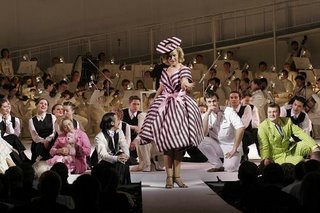G. Rossini, Il Viaggio a Reims, Mariinsky Theater, V. Gergiev (released May 29, 2007) |
The opera, Rossini's last one in Italian, was created for a single performance (eventually allowed to be given a total of four times), in honor of the coronation of Charles X as King of France on May 28, 1825. The rather silly libretto by Luigi Balocchi concerns a group of distinguished guests from all over Europe on their way to Reims for the coronation, all forced to stop at an inn in Plombières. They miss the coronation but are consoled to discover that the festivities will continue in Paris in the following weeks, celebrations that included the performance of a Rossini opera named Il Viaggio a Reims (premiered on June 19, 1825, at the Théâtre Italien in Paris).
The politics of the time are complicated: Charles X, a younger brother of Louis XVI, was an ultra-conservative traditional royalist. He held his coronation at Reims for the connection of that city's cathedral to the Bourbon past, while Napoleon and his successors were crowned in Notre-Dame. Charles X even took part in the ceremony traditionally following a coronation where he laid hands on people suffering from scrofula, a disease thought to be healed by the anointed hands of the king. The ceremony had been discontinued in the 18th century, and this was the last time it was ever witnessed in France.
 Marie Louise Elisabeth Vigée-Lebrun, Portrait of Madame de Staël as Corinne, 1808 |
Rossini went on to recycle many parts of the music from Il Viaggio a Reims in his French comic opera Le Comte Ory. The score of Il Viaggio, believed lost because it was never published, was reconstructed by Janet L. Johnson in the 1970s. Her critical score in the new Rossini complete works edition, published by the Fondazione Rossini in Pesaro, is based on a partial autograph score in the Accademia di Santa Cecilia in Rome, with other original sources in Paris and Vienna. The demands of the score include a stunning total of 14 named roles that clutter the stage, culminating in a Gran Pezzo Concertato for all 14 voices in the final scenes. Little wonder that the opera is rarely performed, and the solution used by the Mariinsky, casting participants in a Young Artists Program, is ingenious.
 It means that the cast has its ups and downs. Although his voice had declined by the time of the 2007 performance at the Kennedy Center, tenor Daniil Shtoda was in grand form as the Russian Count Libenskof in Paris, with strong high notes and clear melismas, even when seated on a white horse in his hilarious entrance amid stereotypical gulps of vodka. Larissa Youdina is a ravishingly platinum blonde Contessa di Folleville (if there ever was a folle ville, Paris is it), with great promise in her voice, capable of shimmering runs and piercing high notes, but sadly sharp and harsh with disappointing frequency here. Also worth note are Anastasia Belyaeva as the Swiss owner of the Golden Lily Inn, Madame Cortese, and Irma Guigolachvili as Corinna, who enters wearing a gown illuminated by light sources within (the outrageous and often beautiful costumes were designed by Mireille Dessingy).
It means that the cast has its ups and downs. Although his voice had declined by the time of the 2007 performance at the Kennedy Center, tenor Daniil Shtoda was in grand form as the Russian Count Libenskof in Paris, with strong high notes and clear melismas, even when seated on a white horse in his hilarious entrance amid stereotypical gulps of vodka. Larissa Youdina is a ravishingly platinum blonde Contessa di Folleville (if there ever was a folle ville, Paris is it), with great promise in her voice, capable of shimmering runs and piercing high notes, but sadly sharp and harsh with disappointing frequency here. Also worth note are Anastasia Belyaeva as the Swiss owner of the Golden Lily Inn, Madame Cortese, and Irma Guigolachvili as Corinna, who enters wearing a gown illuminated by light sources within (the outrageous and often beautiful costumes were designed by Mireille Dessingy). Director Alain Maratrat places the orchestra at the back of the stage, with actors moving among and around the audience on narrow platforms that extend over the pit. (Although the costumes and sets seem to place the action later than 1825, the orchestra is oddly dressed in 18th-century wigs and court livery, which may explain why the pianoforte accompaniment for the recitatives is played instead by a harpsichord.) As travelers arrive at the opening of the opera, conductor Valery Gergiev strides through the house to take his place at the podium. The pit is traditionally in front of the singers for a reason, and Gergiev does his best to keep his forces together. The best part of having the orchestra on the stage is that the harpist featured in Corinna's major arias interacts with the action, as does the flutist who plays the daring obbligato part in Lord Sydney's aria. The minimalist set pieces (designed by Pierre Alain Bertola) are cleverly moved on and off by the chorus. All in all, a pleasing production of an opera worth knowing.
Opus Arte 0967 D
No comments:
Post a Comment